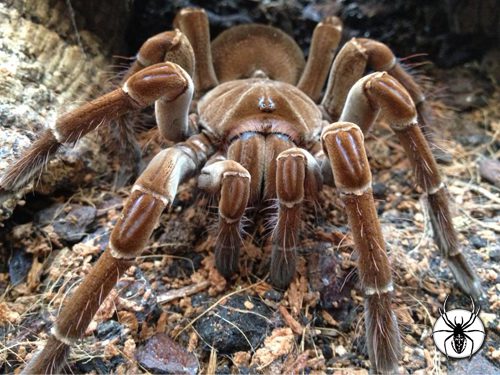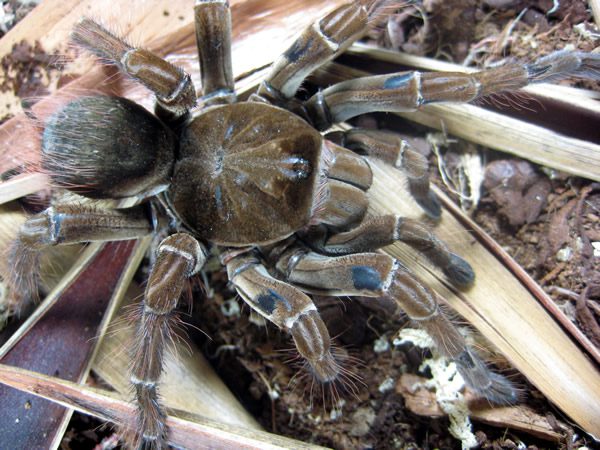Theraphosa stirmi
Guyana Goliath Birdeater (3cm)
Species Info:
Origin
Lifestyle
Temp
Humidity
Leg Span
Disposition
Suitability
This species has only recently entered the hobby. During 2007/2008 we received some of the first direct from Guyana and we noticed that they where different to the T.blondi already in the hobby so decided to list them as Theraphosa sp. “Guyana” until we could work at what they where. At about the same time the Americans had also come to the same conclusion and where listing them as T.sp. “Burgundy” which wasn’t a great choice for a working name as its not really the colour that distinguishes them apart. We took considerable flack for this over various forums in that we where making up a new species in order to sell them. In 2010 they where finally compared and described as Theraphosa strimi a new 3rd Theraphosa species so turns out we where right all along. So what sets them apart from the other two species? In layman’s terms it come down to hairy Knees! Blondi and Apophysis have hairy patella where as Stirmi are bald, other than that they are pretty similar a huge brown spider. As spiderling the T.strimi have Pink Tarsus (Feet) like T.apophysis which blondi don’t have and they retain the pink feet to about 12cm.
This species is a real monster, it is a giant, robust, heavy bodied, fast and powerful Spider. This is probably the most popular species in the Hobby. Uniformly dark brown in body colour covered with dense short setae (hair) which gives it a beautiful suede appearance. There are also some longish reddish hairs on the abdomen and legs. It is interested to observe the changes of coloration of this giant from moult to moult as it can vary from jet black to pale orange.
In wild it inhabits very moist (even swamp) deep rainforests where it lives in deep burrows. They feed on any capable sized prey: insects, small mammals, frogs, lizards and has also been recorded to feed on lethal venomous snakes (West, 1992). In captivity it needs a very ample terrarium with a thick layer of humid substrate. and a big water bowl for drinking. Regular misting of the terrarium provides an increased humidity which is critical for this species. It readily utilizes artificial retreats and you can also decorate the enclosure with artificial plants. This species doesn’t spin much web. In spite of the this Tarantula often being bred as spiderlings it is very hard to breed. The mating is usually successful but females do not produce the eggsacks, or if they do the eggs are often infertile. Eggsacks usually contain less than 100 eggs but the offspring are rather large and around 2cm.
There are a few points about this unique species a potential keeper must bear in mind. Humidity is important to this species and require regular misting, however it also important to have good ventilation so that the enclosure does not get stagnant as this can also be harmful. This species is a voracious eater and fast grower – it can eat and eat and eat and eat…. until the abdomen looks fit to burst, so try not to overfeed it to much. This species also has urticating hairs (type III) which are considered the nastiest among tarantula fauna and can cause serious irritation to the skin. Just the slightest movement of one rear leg rubbing against the abdomen of the is monster raises a whole cloud of this hair. It is also not a docile pet, they have 1.5 – 2cm fangs and can strike a very painful bite. When this monster is distributed it will stridulate which is a hissing sound let you know it is annoyed.

